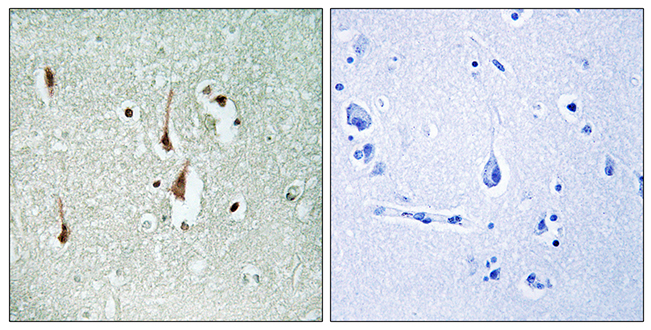Cyclin D1 antibody [N1C3]
GTX108624
ApplicationsImmunoFluorescence, ImmunoPrecipitation, Western Blot, ELISA, ImmunoCytoChemistry, ImmunoHistoChemistry, ImmunoHistoChemistry Paraffin
Product group Antibodies
ReactivityCanine, Feline, Human, Rat
TargetCCND1
Overview
- SupplierGeneTex
- Product NameCyclin D1 antibody [N1C3]
- Delivery Days Customer9
- Application Supplier NoteWB: 1:500-1:3000. ICC/IF: 1:100-1:1000. IP: 1:100-1:500. ELISA: 1:1000-1:10000. *Optimal dilutions/concentrations should be determined by the researcher.Not tested in other applications.
- ApplicationsImmunoFluorescence, ImmunoPrecipitation, Western Blot, ELISA, ImmunoCytoChemistry, ImmunoHistoChemistry, ImmunoHistoChemistry Paraffin
- CertificationResearch Use Only
- ClonalityPolyclonal
- Concentration1 mg/ml
- ConjugateUnconjugated
- Gene ID595
- Target nameCCND1
- Target descriptioncyclin D1
- Target synonymsBCL1, D11S287E, PRAD1, U21B31, G1/S-specific cyclin-D1, B-cell CLL/lymphoma 1, B-cell lymphoma 1 protein, BCL-1 oncogene, PRAD1 oncogene
- HostRabbit
- IsotypeIgG
- Protein IDP24385
- Protein NameG1/S-specific cyclin-D1
- Scientific DescriptionThe protein encoded by this gene belongs to the highly conserved cyclin family, whose members are characterized by a dramatic periodicity in protein abundance throughout the cell cycle. Cyclins function as regulators of CDK kinases. Different cyclins exhibit distinct expression and degradation patterns which contribute to the temporal coordination of each mitotic event. This cyclin forms a complex with and functions as a regulatory subunit of CDK4 or CDK6, whose activity is required for cell cycle G1/S transition. This protein has been shown to interact with tumor suppressor protein Rb and the expression of this gene is regulated positively by Rb. Mutations, amplification and overexpression of this gene, which alters cell cycle progression, are observed frequently in a variety of tumors and may contribute to tumorigenesis. [provided by RefSeq]
- ReactivityCanine, Feline, Human, Rat
- Storage Instruction-20°C or -80°C,2°C to 8°C
- UNSPSC12352203
References
- Lee SC, Shen CY, Wang WH, et al. Synergistic Effect of Ginsenoside Rh2 Combines with Ionizing Radiation on CT26/luc Colon Carcinoma Cells and Tumor-Bearing Animal Model. Pharmaceuticals (Basel). 2023,16(9). doi: 10.3390/ph16091188Read this paper
- Zhang Y, Bao S, Wang D, et al. Downregulation of KLF10 contributes to the regeneration of survived renal tubular cells in cisplatin-induced acute kidney injury via ZBTB7A-KLF10-PTEN axis. Cell Death Discov. 2023,9(1):82. doi: 10.1038/s41420-023-01381-6Read this paper
- Cardile A, Zanrè V, Campagnari R, et al. Hyperforin Elicits Cytostatic/Cytotoxic Activity in Human Melanoma Cell Lines, Inhibiting Pro-Survival NF-κB, STAT3, AP1 Transcription Factors and the Expression of Functional Proteins Involved in Mitochondrial and Cytosolic Metabolism. Int J Mol Sci. 2023,24(2). doi: 10.3390/ijms24021263Read this paper
- Thomas FM, Sudi S, Muhamad Salih FA, et al. Modulation of POPDC1 Expression by Phenothiazine and Trifluoperazine Suppress Colon Cancer Growth and Migration. Asian Pac J Cancer Prev. 2022,23(8):2863-2871. doi: 10.31557/APJCP.2022.23.8.2863Read this paper
- Hung YH, Hsu SH, Hou YC, et al. Semaphorin 6C Suppresses Proliferation of Pancreatic Cancer Cells via Inhibition of the AKT/GSK3/β-Catenin/Cyclin D1 Pathway. Int J Mol Sci. 2022,23(5). doi: 10.3390/ijms23052608Read this paper
- Sudi S, Chin YZ, Wasli NS, et al. Carpaine Promotes Proliferation and Repair of H9c2 Cardiomyocytes after Oxidative Insults. Pharmaceuticals (Basel). 2022,15(2). doi: 10.3390/ph15020230Read this paper
- Huang CY, Weng YT, Li PC, et al. Calcitriol Suppresses Warburg Effect and Cell Growth in Human Colorectal Cancer Cells. Life (Basel). 2021,11(9). doi: 10.3390/life11090963Read this paper
- Tyan YS, Lee YP, Chuang HY, et al. Effects of orlistat combined with enzalutamide and castration through inhibition of fatty acid synthase in a PC3 tumor-bearing mouse model. Biosci Rep. 2021,41(5). doi: 10.1042/BSR20204203Read this paper
- Fan HC, Hsieh YC, Li LH, et al. Dehydroxyhispolon Methyl Ether, A Hispolon Derivative, Inhibits WNT/β-Catenin Signaling to Elicit Human Colorectal Carcinoma Cell Apoptosis. Int J Mol Sci. 2020,21(22). doi: 10.3390/ijms21228839Read this paper
- Li M, Cai J, Han X, et al. Downregulation of circNRIP1 Suppresses the Paclitaxel Resistance of Ovarian Cancer via Regulating the miR-211-5p/HOXC8 Axis. Cancer Manag Res. 2020,12:9159-9171. doi: 10.2147/CMAR.S268872Read this paper






